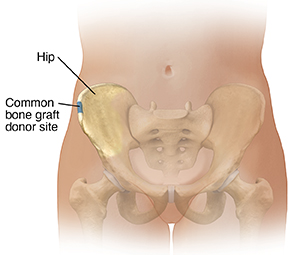Having a Bone Graft
Bone grafting is surgery to repair and rebuild bones that are damaged or diseased. A graft is tissue removed from one place in the body and put in another place. A bone graft may be used to repair bones almost anywhere in your body. Your surgeon may take (harvest) bone from one of your hips, legs, or ribs. The most common place for harvesting bone for a graft is the hip. In some cases, surgeons use bone tissue donated from someone who has died (a cadaver). In other cases, artificial materials may also be used.

What to tell your healthcare provider
Tell your healthcare provider about all the medicines you take. This includes over-the-counter medicines such as ibuprofen. It also includes vitamins, herbs, and other supplements. And tell your healthcare provider if you:
-
Have had any recent changes in your health, such as an infection or fever
-
Are sensitive or allergic to any medicines, latex, tape, or anesthesia (local and general)
-
Are pregnant or think you may be pregnant
Tests before your surgery
Before your surgery, you may need imaging tests. These may include ultrasound, X-rays, CT scan, or MRI.
Getting ready for your surgery
Talk with your healthcare provider how to get ready for your surgery. You may need to stop taking some medicines before the procedure, such as blood thinners and aspirin. If you smoke, stop before your surgery. Smoking can delay healing. Talk with your healthcare provider for help to stop smoking.
Also make sure to:
-
Ask a family member or friend to take you home from the hospital. You cannot drive yourself.
-
Plan some changes at home to help you recover. You may need help at home.
-
Follow any directions you are given for not eating or drinking before surgery.
-
Follow all other instructions from your healthcare provider.
You will be asked to sign a consent form that gives your permission to do the procedure. Read the form carefully. Ask questions if something is not clear.
On the day of your surgery
Your procedure will be done by an orthopedic surgeon. This is a doctor with special training in treating bone, joint, and muscle problems. They will work with a team of specialized staff. Ask your doctor about the details of your surgery. The whole procedure may take a few hours. In general, you can expect the following:
-
You may have general anesthesia. This is medicine that allows you to sleep through the surgery. You won’t feel any pain during the surgery.
-
After cleaning the skin at the site of surgery, your surgeon will make a cut (incision) through the skin and muscle around the bone that needs the bone graft.
-
If bone from another part of your body will be used for the graft, the surgeon will make another incision to remove a small portion of the other bone. This piece of bone will be used for the graft.
-
If using cadaver bone, your surgeon will prepare the piece of bone.
-
Your surgeon will insert the graft bone near the bone that needs to grow together. The graft may be kept in place with special screws or plates.
-
Your surgeon will make any other repairs as needed.
-
Your surgeon will stitch together (suture) the layers of skin and muscle around your treated bone. And if your own bone was used for the graft, that area will also be closed.
-
A healthcare provider will watch your vital signs, like your heart rate and blood pressure, during the surgery.
After your surgery
After surgery, you will be taken to a recovery room. Nurses will check your breathing, heart rate, and blood pressure. Talk with your surgeon about what you can expect after your surgery. You may stay in the hospital for a few days.
You will have some pain after the surgery. Your doctor will tell you what pain medicine you can take to help reduce the pain. Avoid certain over-the-counter medicines for pain as instructed. Some of these may interfere with bone healing.
Recovering at home
Follow all of your surgeon’s instructions about medicines, wound care, and exercises. This will help make sure the surgery is successful. Your surgeon may also tell you to eat foods high in calcium and vitamin D to help with bone healing. Follow all your doctor’s instructions carefully.
Your surgeon will give you detailed instructions about moving the area with the bone graft. You will have a splint or brace if you aren’t allowed to move the area. If your graft is on one of your leg bones, you may have to stay off your leg for a while. Think about what help you may need at home while you heal.
You may have physical therapy to improve the strength and movement of in the bones and joints. The therapy improves your chances of a full recovery.
Follow-up care
Make sure you keep all of your follow-up appointments.
When to call your healthcare provider
Call your healthcare provider right away if you have any of these:
-
Fever of 100.4°F (38°C) or higher, or as advised
-
Chills
-
Redness, swelling, or fluid leaking from your incision that gets worse
-
Pain that gets worse
-
Incision edges that pull apart
-
Loss of feeling in the area